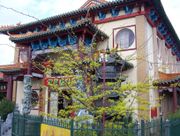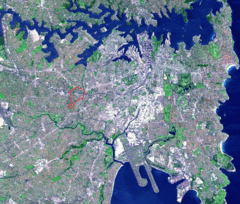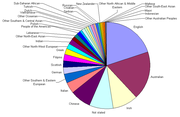Summer Hill, New South Wales
2007 Schools Wikipedia Selection. Related subjects: Geography of Oceania (Australasia)
| Summer Hill | |||||||||||||
| LGA: | Ashfield Council | ||||||||||||
| Established: | 1794 | ||||||||||||
| Postcode: | 2130 | ||||||||||||
| Population: | 6,332 (2001 census) | ||||||||||||
| Median property value: | $634,000 (2005) | ||||||||||||
| Location: | Sydney, NSW | ||||||||||||
|
|||||||||||||
Summer Hill is a suburb in the Inner West area of Sydney, in the state of New South Wales, Australia. It is located approximately 8 kilometres west of the Sydney central business district in the local government area of Municipality of Ashfield.
Summer Hill's shopping precinct is centred around a small town square, and the suburb is popular due to the village-style atmosphere and cafes and restaurants found along Lackey and Smith Streets. The suburb is very small and (by Australian standards) quite old, and features some fine examples of architecture from the 19th and early 20th century. To the north of Summer Hill is the suburb of Haberfield, to the east is Lewisham, to the south is Dulwich Hill, and to the west is Ashfield. The boundaries of Summer Hill are neatly defined by Parramatta Road and Liverpool Road to the North, the rear of the properties on the west side of Prospect Road (with a detour around Trinity Grammar School) to the West, Old Canterbury Road to the South, and the north-south goods railway line to the east.
History
Aboriginal Culture
Prior to the arrival of the First Fleet in Port Jackson in 1788, the area of land we now know as Summer Hill, and surrounding areas, was the home of the Wangal and Cadigal Aboriginal peoples. What is now called the Hawthorne Canal (and was originally the Long Cove Creek) appears to have marked the boundary between the Cadigal and Wangal aboriginal group lands. Today there is a small park in Summer Hill, called Cadigal Reserve, located at 1-4 Grosvenor Crescent. A bronze plaque placed by Ashfield Council names the reserve after the Cadigal (Eora) group of Koori people. Iron Cove and the mangrove-lined estuaries of the Long Cove and Iron Cove Creeks would have provided a good source of fish and molluscs, the most common food of the coastal tribes in the Sydney basin.
In the early days of the colony, the stretch of land between Iron Cove and the Cook's River was known as the Kangaroo Ground. The use of this name suggests that kangaroos were then common in this area, and therefore that the country was probably fairly open (the type of terrain favoured by Kangaroos); and secondly, that kangaroos may have formed a significant part of the aboriginal diet.
No record is known to exist relating to the demise of the aboriginal population from the district. It seems likely that the well-documented outbreak of smallpox among local aboriginal people in early 1789 had a major impact. Governor Phillip not only recorded that half of the local aboriginal population was estimated to have died from the disease, but he also noted that the aboriginal people always "retired from where the diseases appeared" as well.
European Settlement
The first white property ownership in the area that would later become Summer Hill was in 1794, with a grant for a farm to Henry Kable, a former convict and jailor. The land in the eastern corner of Summer Hill was an additional grant of 30 acres (120,000 m²) made to Henry Kable in 1804. A little later in the century this eastern corner would become part of the estate of James Underwood. Underwood died in 1844 and left a will so complicated that it required special legislation before it could be subdivided.
The earliest known use of the name "Summer Hill" was in 1876, for a land subdivision adjacent to the present-day St Andrews church. The name Summer Hill is thought to be a name chosen by the land sub-divider, presumably based on an attachment for England. Local historians regard the suggestion that the name is a derivation of "Sunning Hill" as a dubious story which has no substance.
Summer Hill's largest mansion, Carleton, was built in the early 1880s on Liverpool Road for Charles Carleton Skarrat. The suburb boomed with the opening of the railway station in 1879, and the subdivisions of much of the surrounding area followed. Between 1880 and 1910, the area became an upper-class suburb, and was a popular choice for city-types who worked in banking and insurance. Subdivision of gardens for housing continued in the 1920s and 1930s, and socioeconomically the suburb changed as some of the wealthier inhabitants moved to the North Shore. Demolition of most of the surviving mansions occurred in the 1970s to allow erection of home units, especially within walking distance of the railway station.
Characteristics
Summer Hill features a mix of federation-era houses and medium density apartment blocks near the railway station. Local independent business people run most of the shops, giving the area quite a friendly and community-focused atmosphere. It has been christened "the village".
Summer Hill is a suburb rich in heritage. More than one hundred properties are heritage listed, and a current review will add to this number. This is a result of some residents of the suburb feeling very strongly about protecting the local architecture.
Despite formerly being rather working class, Summer Hill and many of the surrounding suburbs have gradually undergone gentrification over recent years. Culturally, Summer Hill is a unique blend of medium-density European Sydney suburbia, with Italian influences (which are most strongly evident in Leichhardt to the East and Haberfield to the North), Eastern influences (which are most strongly evident in Ashfield to the West), and smaller influences from many other cultures.
Residents
In the 2001 Australian Bureau of Statistics Census of Population and Housing, the population of the Summer Hill postcode area was 6332 people, in an area of 1.1 square kilometres. The population was 51% females, 49% males. 53% of the population was born overseas (see chart for a breakdown of ancestry). The eight strongest religious affiliations in the area were in descending order: Catholic, No religion, Anglican, Buddhism, Orthodox Christian, Uniting Church, Presbyterian and Reformed, and Islam. The three most common forms of dwelling were in decreasing order: a flat, unit or apartment; a separate house; a semi-detached, row or terrace house, or townhouse.
Notable Residents
The following notable people were born or lived in Summer Hill:
- Colonel Matron Kathleen Best.
- Ninram Melville Junior - a well-known Sydney furniture maker and mortician who subsequently became the Mayor of Ashfield, and a parliamentarian.
- Normand Henry Baker - Archibald Prize winning artist.
- Dr John Belisarro - Dentist at the later end of the 19th century, recorded as living in Summer Hill in the 1891 census. First dentist in Australia to administer ether to a patient to carry out dental work.
- Arthur Streeton - Famous Australian artist who briefly lived in Summer Hill.
- David Elphinstone.
- Edwin Johnson - Education reformer, undersecretary to the Department of Public Instruction.
- Justice Greg James.
- Ian Temby, QC.
- Rt Hon Sir Cyril Walsh, lawyer and Justice of the High Court of Australia
- Sir Tristan Balogh - Famous Australian musician, lived in the suburb most of his life.
Transport
In the 2001 census, for people travelling to work using just one method of transportation from this postcode, 45% travelled in a car as the driver, 40% took the train, 5% walked, 4% travelled in a car as passenger, 4% took the bus, 1% travelled by bicycle, and 1% travelled by truck. By road Summer Hill is located close to Liverpool Road and Parramatta Road, and so is well served by road, although in peak hour these roads are quite congested.
Summer Hill railway station is located on the Inner west line of the CityRail network. The railway station was opened in 1879, and most of the local shops are clustered close to the station. Travelling towards the city, the railway stops in order are Lewisham, Petersham, Stanmore, Newtown, Macdonaldtown, Redfern, Central, and Town Hall. Travelling west towards Strathfield, the stops are Ashfield, Croydon, Burwood, and Strathfield. A recent renovation of the railway station was completed in 2004, after a public outcry about the ugliness and overwhelming size of a proposed overhead pedestrian walkway. The revised design used the more expensive option of refurbishing the existing underground walkway.
There are five Sydney bus routes that service the area—the 480 and 483 follow routes along Parramatta and then Liverpool roads, the 461 travels along Parramatta Road, the 413 travels along Junction Road, and some 409 buses stop at the railway station outside of peak hour.
The area is gradually becoming more bicycle friendly.
Attractions
The Summer Hill flour mill was built circa 1922, utilising the north-south goods railway line that was constructed during World War 1. The silos were added from the 1950s onwards. The flour mill has been owned by various companies, including Mungo Scott, and Goodman Fielder, and is currently owned by Allied Mills.
Trinity Grammar School is located across Prospect Road from the Prospect Hall estate. The site of the school has been in continuous use for educational purposes for 120 years. The Headmaster's house building at Trinity was erected circa 1877. The site operated as several different teaching institutions, until it was purchased by the Anglican Church, and became known as Trinity Grammar School in 1925. Trinity Grammar is one of many wealthy schools in New South Wales, and has previously received some of the largest federal funding grants (as government grants to private schools are partially based on postcodes, and the school is located in a not especially wealthy postcode).
There are a number of places of worship in Summer Hill. St Patrick's church is a Catholic church located in the oldest known still standing building in the area, built in 1874. There is also a small primary school associated with the church and located next to it. The building was originally a private home known as Kelvin Grove, and owned by Mrs Jane Drynan. However none of the original internal walls were retained when the building was converted into a church. Much of the exterior fabric of the church is however original, and the church has recently been renovated internally. Following Drynan's death, Kelvin Grove was owned or leased by a succession of different people, including the Haberfield real-estate developer Richard Station, the Croydon brick-maker William Downton, and two sisters namely Freeman (one of whom was a nurse). In the 1920s and 30s Kelvin Grove may have been used as a nursing home. The first mass was celebrated in Kelvin Grove on St Patrick's day 1946, which gave the church its name.
St Andrew's Anglican Church has three distinctive internal transept arches, and was designed by a Presbyterian, Alexander Leckie Elphinstone junior. The foundation stone was laid in 1883, and the top of the spire completed in 1906. The fast construction period, unusual for that time, was indicative of the area's affluence. Recent Asian influences in Summer Hill have brought about the introduction of non-Christian places of worship. The Wong Tai Sin / Kwan Yin Kur temple is located on the corners of Kensington Road and Liverpool Road, and occupies a building that was a Masonic temple in the 1920s. The same building was retained and converted into the current temple; the lower floor houses the Taoist deity of Wong Tai Sin, and the upper floor houses the Buddhist Bodhisattva of Kwan Yin.
The Ashfield Carnival of Cultures has been running since 1996, and has grown to become one of the leading multicultural festivals in Sydney's Inner West. The carnival is organised by Ashfield Council and is held annually on the second Sunday of October in Ashfield Park. It features free attractions and cultural performances, as well as stalls selling knick-knacks and an eclectic mix of foods. Ashfield Park also hosts the annual 'Carols by Candlelight' in early December. Other events include the 'Authors at Ashfield' series, held in Ashfield Library, where you can meet a writer and ask them questions on their experiences. Ashfield Council also maintains a list of upcoming events.
Politics
|
|
|||||||||||||||||||||||||||||||||||||||
Summer Hill is in the safe Labor federal electoral division of Grayndler. This seat is currently held by Labor shadow minister Anthony Albanese, who was last re-elected in the 2004 general election. The seat has been held continuously by Labor since it was proclaimed in 1949.
For NSW state elections, Summer Hill is predominantly in the Electoral district of Strathfield. Summer Hill was added to this state seat when the safe Labor electorate of Ashfield was abolished in 1999. From 1999 to 2003 it was held by Paul Whelan (the former State Police minister) of the Australian Labor Party. This seat is currently held by Virginia Judge, of the Australian Labor Party.
Local political issues include:
- Proposed construction of the M4 East, diverting traffic from Parramatta Road, and which construction option should be used.
- Opposition to plans that would result an increase in traffic at Kingsford Smith International Airport, and thus more aircraft noise.
- Concern over the proposed new supermarket building, and whether it is in keeping with the local shopping area.







